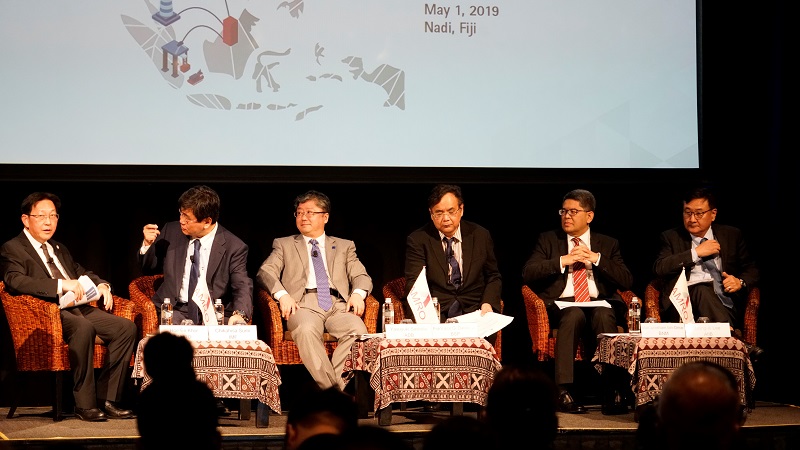NADI, FIJI, May 1, 2019 – ASEAN+3 economies, after two decades of prospering with the “manufacturing-for-exports” strategy, should now focus on building capacity and connectivity to leverage on the Fourth Industrial Revolution in order to sustain growth in the new economy. This was underscored by participants at the seminar on “Building Connectivity and Capacity for the New Economy in East Asia” organized by the ASEAN+3 Macroeconomic Research Office (AMRO).
The key findings of the thematic study in the ASEAN+3 Regional Economic Outlook (AREO) 2019 was presented at the seminar to set the context for discussion. Speakers and participants, including high-level policymakers and senior officials of international organizations, shared their insights and perspectives on how the region could prepare itself for the new economy, sustain robust growth, and continue to embrace and benefit from globalization, at a time when protectionist tendencies in the trade and technology space are rising.

Panelists discuss drivers, gaps, and policy implications on building capacity and connectivity for the new economy. From left to right: AMRO Chief Economist Hoe Ee Khor; Chikahisa Sumi, Director, Office of Asia Pacific, International Monetary Fund; Yasuyuki Sawada, Chief Economist, Asian Development Bank; Francisco G. Dakila, Jr., Assistant Governor of the Monetary Policy Sub- Sector, Bangko Sentral ng Pilipinas; Marzunisham bin Omar, Assistant Governor, Bank Negara Malaysia; Dong-ik Lee, Vice President and Director General of the Investment Operations Department, Asian Infrastructure Investment Bank
“ASEAN+3 economies have come a long way since the 1997 Asian Financial Crisis. They have collectively transformed from being a crisis-shaken region in the late 1990s to one which stood resilient against the Global Financial Crisis in the late 2000s, and which is now positioning itself for many more years of rapid growth. For the next phase of economic development, the region needs to redouble its efforts to enhance capacity and cross-border connectivity in order to successfully transition to the new economy,” said AMRO Director Dr. Junhong Chang in her opening remarks.
In his presentation, AMRO Chief Economist Dr Hoe Ee Khor noted that while the move up the technological frontier has been, and will continue to be, uneven, the transformation to services is inevitable. Consequently, it will require a rethink of what capacity means, and what connectivity is needed in the new economy. Globally, manufacturing and services will be transformed by the Fourth Industrial Revolution. Going forward, they will require higher levels of technology, expertise and connectivity to deliver customized goods, services, and above all, experiences to an increasingly large and affluent middle class.

AMRO Director Dr Junhong Chang emphasizes need for the ASEAN+3 economies to build capacity and connectivity to successfully transition to the New Economy.
The panel discussed three key drivers that will shape capacity and connectivity priorities in the region over the short- to medium term. These include the Fourth Industrial Revolution and the new economy, involving rapid technological advancement and a much bigger role for the services sector; maturing populations, and a rapidly growing middle class driving demand for goods and services and propelling innovation and a shift to more customized services; and deepening regional integration spurred by market forces and rising protectionist tendencies elsewhere.
The panel also noted that developing economies in the region continue to face three key challenges to growth, namely the funding, foreign exchange, and factors gaps.
To bridge the funding and foreign exchange gaps, the region should continue to leverage on its savings and investments and strengthen the regional financial safety net to safeguard financial stability and economic resilience. In recent years, ASEAN+3 developing economies have benefited from growing intra-regional investments. The region as a whole also has ample foreign reserves, and a further strengthening of the regional financial safety net, centered on the Chiang Mai Initiative Multilateralisation, will provide a strong anchor for the region to continue pursuing rapid and high-quality growth.
To meet the factors gap, the region should continue developing professional expertise, technology and institutions, and leverage on various initiatives to build regional capacity and connectivity, such as the Belt and Road Initiative, the Master Plan for ASEAN Connectivity, and the ASEAN Framework Agreement on Services.
—
About AMRO:
The ASEAN+3 Macroeconomic Research Office (AMRO) is an international organization established to contribute towards securing macroeconomic and financial stability of the ASEAN+3 region, which includes 10 members of the Association of Southeast Asian Nations (ASEAN) and China; Hong Kong, China; Japan; and Korea. AMRO’s mandate is to conduct macroeconomic surveillance, support the implementation of the regional financial arrangement, the Chiang Mai Initiative Multilateralisation (CMIM), and provide technical assistance to the members.
